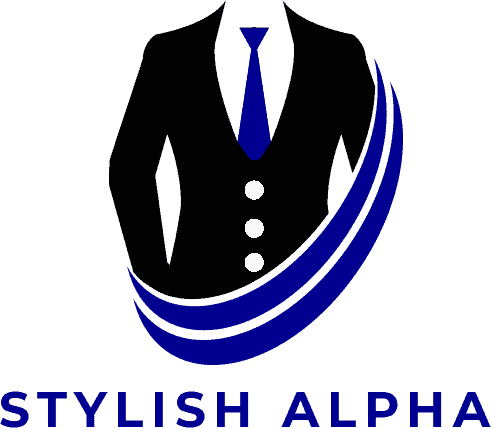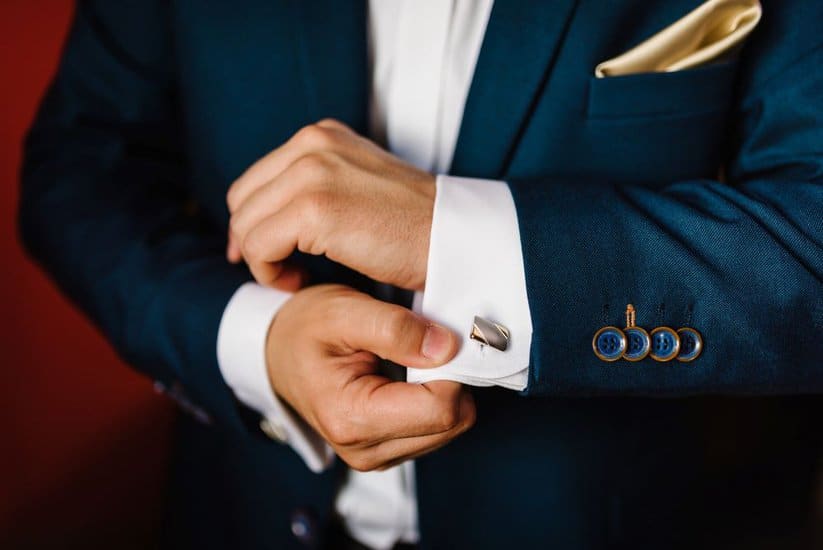Cufflinks are more than just functional; they’re a touch of elegance that can elevate a dress shirt to the next level of sophistication. Whether it’s a wedding, an important business meeting, or any formal event, realizing you’ve forgotten your cufflinks can send you into a sartorial panic. However, there are several ways to handle such a cuff-linked conundrum with poise and finesse.

I understand that cufflinks signify meticulous attention to detail on a well-curated ensemble. Therefore, when the unforeseen happens, and those small accessories are nowhere to be found, it’s essential to remain composed and resourceful.
Over the years, I’ve picked up quite a few tricks to ensure my appearance remains sharp, even when traditional cufflinks are not an option. These hacks can be real outfit-savers, allowing you to maintain a polished look without skipping a beat.
Key Takeaways on What to Do If You Forgot Cufflinks
- Cufflinks add elegance and are a key detail in a formal outfit.
- Resourcefulness can save the situation when cufflinks are forgotten.
- Maintaining poise and creativity ensures a polished look without traditional cufflinks.
Check out these other top sought posts:
Understanding Cufflinks
Before diving into the intricate world of cufflinks, it’s essential to know that they are not just fasteners; they are a statement of style and elegance. My aim here is to help you understand their varieties and the multitude of materials and designs they come in.
Types of Cufflinks
There are several cufflink styles that cater to various preferences and occasions. The whale back cufflink is one of the most common types with a flat head, a whale tail that flips flat against the post. The bullet back cufflink is similar but has a cylindrical back that flips inside to secure. For a more traditional or vintage appeal, chain link cufflinks provide a loose closure with two decorative faces connected by a chain.
Another popular choice is knot cufflinks, often fashioned from silk or rope with a knot on each end for a simple yet elegant look. Each type of cufflink serves the same purpose but offers a distinct aesthetic and ease of use that I find intriguing.
Materials and Designs
Cufflinks are made from a diverse array of materials, introducing a fascinating aspect of personalization and character to your outfit. Here’s an overview of common materials:
- Precious metals: luxury cufflinks are often made from gold, silver, or platinum.
- Metal: less expensive options can be crafted from stainless steel or brass.
- Glass or Stone: for a more decorative look often paired with metal fittings.
- Titanium: a modern, lightweight metal known for its durability.
- Leather: can add a textured, masculine element to the design.
- Wood: a warm, rustic option for a unique touch.
- Enamel: provides opportunities for vibrant colors and intricate designs.
The design of cufflinks I’ve seen spans from the traditional and understated to the bold and flamboyant. The choice of material and design greatly depends on personal style and the occasion, whether that’s a regular day at the office or a formal gala event. Precious metal cufflinks studded with gemstones make an opulent statement, whereas silk knots offer a more subdued elegance.
Preparing for Dressing Without Cufflinks

When dressing in a formal attire, the absence of cufflinks for a French cuff shirt can be challenging. However, I understand several practical solutions to address this sartorial dilemma, ensuring a polished look without traditional cufflinks.
Alternative Fastening Techniques
French cuffs are designed to be closed with cufflinks, but when none are available, I recommend a few resourceful techniques. Firstly, utilizing a sturdy paper clip can save the day. By folding my French cuffs back as if I were inserting cufflinks and then sliding the paper clip through the holes, keeping them securely fastened.
A second method involves repurposing small items like a tie bar to pinch the cuffs together, although this requires a bit more finesse and the size should match the cuff’s width.
Cufflinks Substitutes
Besides using paper clips or tie bars, you might find other impromptu items around you that can serve as cufflinks. For instance, you could thread a small, clean piece of string or even dental floss through the cuff holes, tying it on the inside of the sleeve so it’s not visible. If you’re feeling creative, you might even fashion cufflinks from small, neat knots made of elastic bands.
Remember, these solutions are temporary and should be discreet so they don’t detract from the formality of your attire. Additionally, if you’re wearing a jacket, the sleeves can often conceal these makeshift solutions from view, helping you maintain a professional appearance.
In the situation where you’ve forgotten your cufflinks but still wish to adhere to a traditional style, you could consider visiting nearby stores or asking a friend if they have a pair you could borrow. If time allows, purchasing simple and elegant cufflinks on the go is also a great option to handle the situation with grace.”
Choosing Shirts for Various Occasions

When attending different events, the shirt you choose plays a crucial role in matching the formality of the occasion. It’s important to understand which types of shirts are appropriate for various settings, from formal events to casual gatherings.
1. French Cuff Shirts
French cuff shirts are synonymous with formality and refinement in menswear. They are ideal for formal events like weddings or black-tie affairs and require cufflinks to fasten the cuffs. Pairing a classic white French cuff shirt with a tuxedo maintains an elegant and cohesive look.
2. Business and Casual Options
For work settings that lean towards business professional attire, a crisp shirt with standard buttoned cuffs typically suffices. However, when a touch of sophistication is desired, opting for a shirt that accommodates simple cufflinks can enhance your business attire.
On the other hand, a casual look works well with shirts that have button cuffs and offer a relaxed fit. These are versatile enough for business casual environments or social settings, where the mood is less formal and the dress codes more flexible.
3. Coordinating with Other Accessories
When you forget your cufflinks, you can turn to other accessories in your collection to ensure your look remains sharp and well-coordinated. The key is to match metals and complement colors between items like watches and rings, or tie bars and jewelry, to maintain a cohesive appearance.
4. Watches and Rings

Your watch and rings are often the first accessories to consider when pulling an outfit together without cufflinks. If your watch has a silver tone, select rings that either match or complement that same silver finish. For instance, a watch with a stainless steel band pairs perfectly with a platinum or white gold ring. It’s this attention to detail that keeps your ensemble refined despite the absence of cufflinks.
5. Tie Bars and Jewelry
The tie bar is another accessory that steps into the spotlight when cufflinks are not an option. To create a coherent look, ensure your tie bar matches the metal of your other accessories. For example, a yellow gold tie bar would harmonize with gold-toned jewelry. Maintaining subtle and sophisticated coordination by tying together these elements ensures each piece contributes to an overall dapper profile.
Dressing Etiquette for Formal Occasions

When attending formal occasions, it’s essential to get the details right. The focus is not just on choosing a suit or tuxedo but also ensuring that accessories like cufflinks are appropriate and match the occasion. I’ll guide you through the standards for weddings and black-tie events as well as business and state functions.
Weddings and Black-Tie Events
For weddings and black-tie events, I recommend wearing a tuxedo with a French cuff or double cuff shirt. These shirts require cufflinks, and the size should be modest to complement, not overpower, the ensemble. Silver or gold cufflinks with a simple design are a classic choice. When I attend such events, I ensure my cufflinks match the overall elegance of the occasion.
Business and State Functions
In more formal business settings or state functions, I opt for a sharp suit and a jacket with French cuff shirts. Here, the cufflinks I choose are often more reserved. If I am taking a leadership role, such as a CEO at a formal event, I select cufflinks that exude professionalism and command respect, ensuring they harmonize with my suit’s color and style.
Building and Maintaining a Cufflink Collection

In building and maintaining a cufflink collection, choosing the right styles and caring for them properly are crucial. Quality cufflinks can last a lifetime when they’re selected wisely and stored correctly.
Starting Your Collection
I recommend beginning your collection with a variety of styles that suit different occasions. Start with basic chain link cufflinks or knot cufflinks since they are versatile and easily match a variety of outfits.
As you expand, consider acquiring cufflinks that feature cufflink materials like precious stones, including rubies or abalone, and colored glass for more formal events. Silken knot or silk knot options also offer a less formal but still stylish choice. When choosing cufflinks, think about your personal style, the type of jewelry you typically wear, and how the cufflinks will complement your wardrobe.
Care and Storage
Proper care and storage of your cufflinks are key to ensuring their longevity. Here’s how I suggest maintaining your collection:
- Cleaning: Gently clean your cufflinks after each use. For metals, use a soft cloth and for dirtier cufflinks, mild soap and water, but ensure they’re completely dry before storing.
- Storage: Keep your cufflinks in a dedicated jewelry box or a cufflink case with compartments to prevent scratching. For how to store a cufflink collection, separators are crucial to avoid them knocking into each other.
- Silk Knots: These should be loosely coiled and stored in a compartment to prevent them from unraveling or creasing.
Innovating with Cufflinks as a Statement Piece

In my experience with fashion and accessories, cufflinks offer an exceptional opportunity to make a statement. They are not just functional shirt fasteners but also key to enhancing my aesthetic appeal.
Innovating with Cufflinks as a Statement Piece
Cufflinks offer an exceptional opportunity to make a statement. They are not just functional shirt fasteners but also key to enhancing your aesthetic appeal.
Aesthetic and Visual Impact
The visual significance of cufflinks is unmistakable. You can choose cufflinks that not only hold your shirt cuffs together but also complement your outfit and add a touch of sophistication. Patterns range from understated classics to bold, modern designs; each has its place depending on the style of the shirt and the occasion.
It’s not just about color or material, but how the cufflinks’ design can seamlessly augment the aesthetic of your attire. For example, the intricate detail of a paisley pattern or the sleek finish of polished metal can elevate your visual presentation considerably.
Custom and Unique Designs
The world of custom cufflinks is vast and alluring. By selecting bespoke cufflinks, tailored just for you, you are not only injecting a piece of your personality into your ensemble but also ensuring your style is unique. Materials can vary, from stainless steel to precious metals, and the inclusion of personalized engravings or custom-cut gemstones serves as a talking point and a reflection of your personal history or interests. C
ustom cufflinks are not only accessories; they are tiny art pieces that express individuality and style. For instance, you might opt for cufflinks that feature your initials, or that echo the theme of an event you’re attending, thus making them both a custom embellishment and a functional component of your outfit.”
Troubleshooting Common Cufflink Issues

When cufflinks malfunction or do not match an outfit, it can be a source of frustration. The following tips will help rectify common issues related to cufflinks so that they complement French cuff shirts and ensure a seamless look with various types of dress pants and outfits.
Damaged or Loose Cufflinks
If cufflinks become loose or damaged, it’s often due to wear and tear on the mechanisms. Specifically, with bullet back cufflinks and whale back cufflinks, the closure can wear out, potentially leading to a cufflink coming undone.
Chain link cufflinks and ball return cufflinks may suffer from a broken chain or loose ball, respectively. To address loose backing, gently tighten the closure where possible. In cases of damage, such as for fixed backing cufflink or locking cufflink, if they cannot be fixed by hand, it may be necessary to visit a jeweler who can repair or replace the damaged parts.
Mismatched Cufflinks and Outfits
Cufflinks should always complement the outfit. For double cuffs or French cuff shirts, choosing the right cufflink is crucial for achieving a polished appearance. For instance, hinged cufflinks with a simple design work well for business settings, while more ornate options may be suitable for formal events.
If the cufflinks clash with the outfit—for example, gold cufflinks with a silver watch—an easy solution is to match metallic colors or choose a neutral, universally-matching color like silver. It’s important to ensure that the style and sophistication of the cufflink reflect the formality of the attire and occasion.
Frequently Asked Questions

In this section, I address the most common concerns and provide practical solutions when you find yourself without cufflinks.
How can I secure a french cuff shirt without cufflinks?
When you don’t have cufflinks for a French cuff shirt, you can use small items such as twist ties or a sturdy piece of string to thread through the cuff holes, tying them securely behind the cuff.
What are some alternatives to traditional cufflinks?
As alternatives to traditional cufflinks, you might consider using items like silk knots, metal collar stays, or even small lockets that can slide through the holes of the shirt cuffs.
How to make homemade cufflinks from items like buttons?
To create homemade cufflinks, you can choose a pair of matching buttons and fasten them together with a strong thread or fine wire, mimicking a cufflink’s chain to secure the cuffs.
Can cufflinks be improvised with office supplies like paperclips?
I have found that in an emergency, a paperclip can be bent into a makeshift cufflink. I simply unfold it to create a U-shape and slide each end through the cuff holes, then twist to secure it on the underside.
Is it acceptable to wear a cufflink shirt without cufflinks?
In more casual settings, it’s perfectly fine for you to wear a cufflink shirt without cufflinks by simply folding the cuffs back as if they were barrel cuffs, or you can roll the sleeves up for an informal look.
What types of shirts are compatible with cufflinks?
Cufflinks are suitable for shirts with French or double cuffs, as these have holes on both sides of the cuff opening where you can fasten the cufflink through.

Samoel Ovanessian is the founder and creator of StylishAlpha.com – a website dedicated to men’s fashion. As a proud owner of more than 200 ties, he loves digging through new clothing combinations for everyday use, formal events and even just for fun. You can read more about Samoel here.

